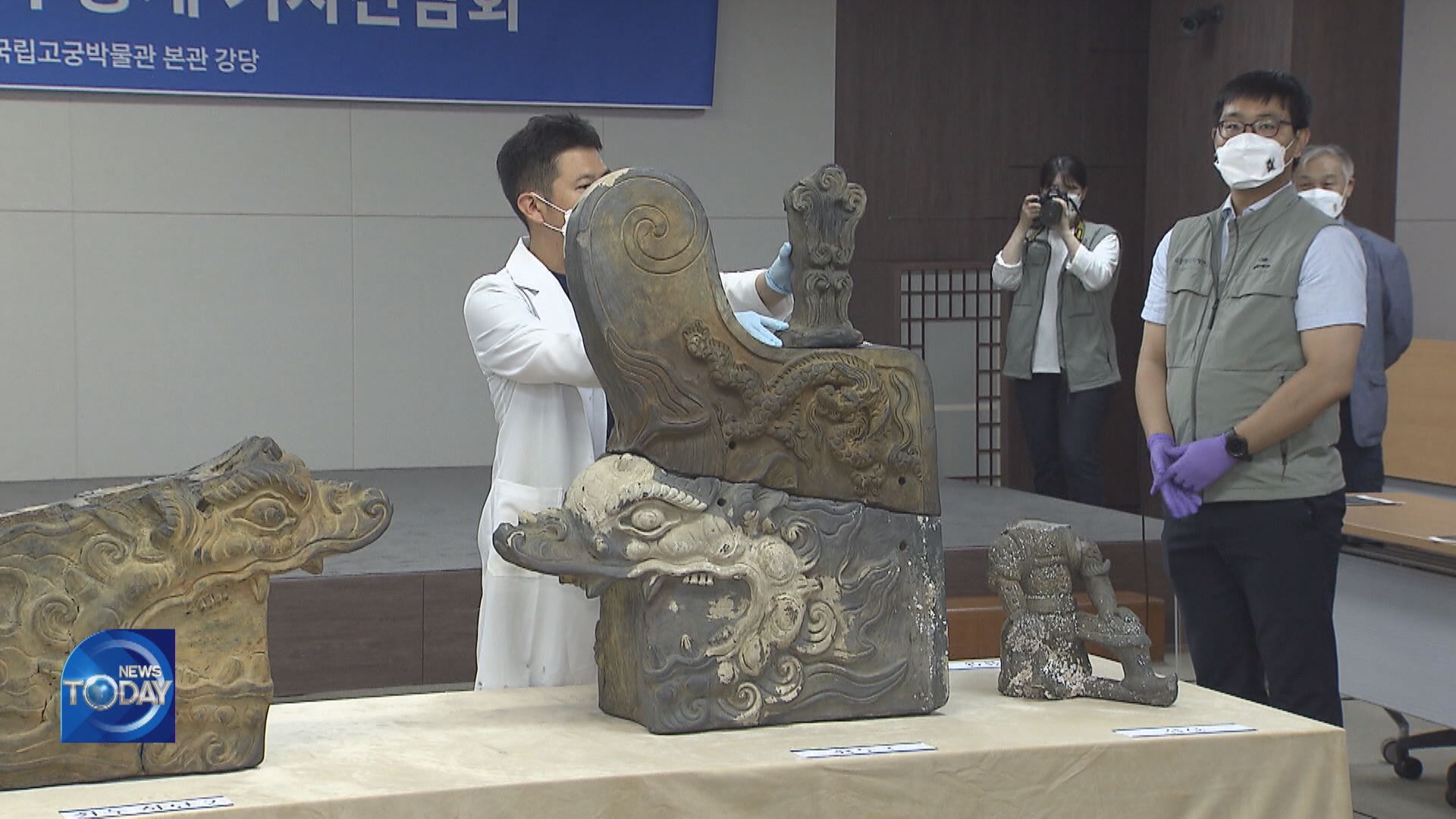DISCOVERY OF ANCIENT ROOF TILES
입력 2022.06.30 (14:55)
수정 2022.06.30 (16:46)
읽어주기 기능은 크롬기반의
브라우저에서만 사용하실 수 있습니다.
[Anchor Lead]
Joseon-era roof tiles were discovered in mud flats of Taean, Chungcheongnam-do Province. They are believed to have been produced to decorate the roofs of royal buildings during the Joseon Dynasty. The valuable relics will help identify the exact form of decorative roof tiles produced in the early days of the dynasty.
[Pkg]
Mudflat off Cheongpodae beach in Taean, Chungcheongnam-do Province. After digging into the mud flat for a good while, buried ancient objects appear one after another. There is something that looks like a sword hilt. As the shards were assembled together a shape like this was formed. A dragon head is on the lower side and a tiny dragon is on the upper side, with the hilt object at the top. What is this? When looking up at the roof of a palace, there are some things that stand out at both ends of its ridges. It is a decorative roof tile called chwidoo. With the two parts of the main body and the hilt-like shard, the new discovery was restored in its original form.
[Soundbite] Kim Dong-hoon(Nat’l Research Institute of Maritime Cultural Heritage) : "Archaeologically, it is very meaningful, since this is the first time we discovered a chwidoo in its entirety."
In the form and patterns of the hilt-like ornament called geompa, the tile is different from those produced during the later days of the Joseon Dynasty. A statue of a military commander, discovered in the same region, shows the characteristics of the style popular during Joseon’s early days. Archaeologists believe the decorative roof tile is also from the same period. This is why the new discoveries are considered special and valuable.
[Soundbite] Kim Seong-gu(Former Director of Gyeongju Nat’l Museum) : "They were used for royal palaces. Now it is nearly perfect. It is good enough to be designated as a national treasure after the excavation is completed."
Presuming that a ship carrying roof tiles produced in Seoul must have sank off the coast of Taean, the research team plans to conduct more excavation projects under water and explore if there are other relics and remnants from a ship wreck.
Joseon-era roof tiles were discovered in mud flats of Taean, Chungcheongnam-do Province. They are believed to have been produced to decorate the roofs of royal buildings during the Joseon Dynasty. The valuable relics will help identify the exact form of decorative roof tiles produced in the early days of the dynasty.
[Pkg]
Mudflat off Cheongpodae beach in Taean, Chungcheongnam-do Province. After digging into the mud flat for a good while, buried ancient objects appear one after another. There is something that looks like a sword hilt. As the shards were assembled together a shape like this was formed. A dragon head is on the lower side and a tiny dragon is on the upper side, with the hilt object at the top. What is this? When looking up at the roof of a palace, there are some things that stand out at both ends of its ridges. It is a decorative roof tile called chwidoo. With the two parts of the main body and the hilt-like shard, the new discovery was restored in its original form.
[Soundbite] Kim Dong-hoon(Nat’l Research Institute of Maritime Cultural Heritage) : "Archaeologically, it is very meaningful, since this is the first time we discovered a chwidoo in its entirety."
In the form and patterns of the hilt-like ornament called geompa, the tile is different from those produced during the later days of the Joseon Dynasty. A statue of a military commander, discovered in the same region, shows the characteristics of the style popular during Joseon’s early days. Archaeologists believe the decorative roof tile is also from the same period. This is why the new discoveries are considered special and valuable.
[Soundbite] Kim Seong-gu(Former Director of Gyeongju Nat’l Museum) : "They were used for royal palaces. Now it is nearly perfect. It is good enough to be designated as a national treasure after the excavation is completed."
Presuming that a ship carrying roof tiles produced in Seoul must have sank off the coast of Taean, the research team plans to conduct more excavation projects under water and explore if there are other relics and remnants from a ship wreck.
■ 제보하기
▷ 카카오톡 : 'KBS제보' 검색, 채널 추가
▷ 전화 : 02-781-1234, 4444
▷ 이메일 : kbs1234@kbs.co.kr
▷ 유튜브, 네이버, 카카오에서도 KBS뉴스를 구독해주세요!
- DISCOVERY OF ANCIENT ROOF TILES
-
- 입력 2022-06-30 14:55:26
- 수정2022-06-30 16:46:03

[Anchor Lead]
Joseon-era roof tiles were discovered in mud flats of Taean, Chungcheongnam-do Province. They are believed to have been produced to decorate the roofs of royal buildings during the Joseon Dynasty. The valuable relics will help identify the exact form of decorative roof tiles produced in the early days of the dynasty.
[Pkg]
Mudflat off Cheongpodae beach in Taean, Chungcheongnam-do Province. After digging into the mud flat for a good while, buried ancient objects appear one after another. There is something that looks like a sword hilt. As the shards were assembled together a shape like this was formed. A dragon head is on the lower side and a tiny dragon is on the upper side, with the hilt object at the top. What is this? When looking up at the roof of a palace, there are some things that stand out at both ends of its ridges. It is a decorative roof tile called chwidoo. With the two parts of the main body and the hilt-like shard, the new discovery was restored in its original form.
[Soundbite] Kim Dong-hoon(Nat’l Research Institute of Maritime Cultural Heritage) : "Archaeologically, it is very meaningful, since this is the first time we discovered a chwidoo in its entirety."
In the form and patterns of the hilt-like ornament called geompa, the tile is different from those produced during the later days of the Joseon Dynasty. A statue of a military commander, discovered in the same region, shows the characteristics of the style popular during Joseon’s early days. Archaeologists believe the decorative roof tile is also from the same period. This is why the new discoveries are considered special and valuable.
[Soundbite] Kim Seong-gu(Former Director of Gyeongju Nat’l Museum) : "They were used for royal palaces. Now it is nearly perfect. It is good enough to be designated as a national treasure after the excavation is completed."
Presuming that a ship carrying roof tiles produced in Seoul must have sank off the coast of Taean, the research team plans to conduct more excavation projects under water and explore if there are other relics and remnants from a ship wreck.
Joseon-era roof tiles were discovered in mud flats of Taean, Chungcheongnam-do Province. They are believed to have been produced to decorate the roofs of royal buildings during the Joseon Dynasty. The valuable relics will help identify the exact form of decorative roof tiles produced in the early days of the dynasty.
[Pkg]
Mudflat off Cheongpodae beach in Taean, Chungcheongnam-do Province. After digging into the mud flat for a good while, buried ancient objects appear one after another. There is something that looks like a sword hilt. As the shards were assembled together a shape like this was formed. A dragon head is on the lower side and a tiny dragon is on the upper side, with the hilt object at the top. What is this? When looking up at the roof of a palace, there are some things that stand out at both ends of its ridges. It is a decorative roof tile called chwidoo. With the two parts of the main body and the hilt-like shard, the new discovery was restored in its original form.
[Soundbite] Kim Dong-hoon(Nat’l Research Institute of Maritime Cultural Heritage) : "Archaeologically, it is very meaningful, since this is the first time we discovered a chwidoo in its entirety."
In the form and patterns of the hilt-like ornament called geompa, the tile is different from those produced during the later days of the Joseon Dynasty. A statue of a military commander, discovered in the same region, shows the characteristics of the style popular during Joseon’s early days. Archaeologists believe the decorative roof tile is also from the same period. This is why the new discoveries are considered special and valuable.
[Soundbite] Kim Seong-gu(Former Director of Gyeongju Nat’l Museum) : "They were used for royal palaces. Now it is nearly perfect. It is good enough to be designated as a national treasure after the excavation is completed."
Presuming that a ship carrying roof tiles produced in Seoul must have sank off the coast of Taean, the research team plans to conduct more excavation projects under water and explore if there are other relics and remnants from a ship wreck.
이 기사가 좋으셨다면
-
좋아요
0
-
응원해요
0
-
후속 원해요
0

















이 기사에 대한 의견을 남겨주세요.